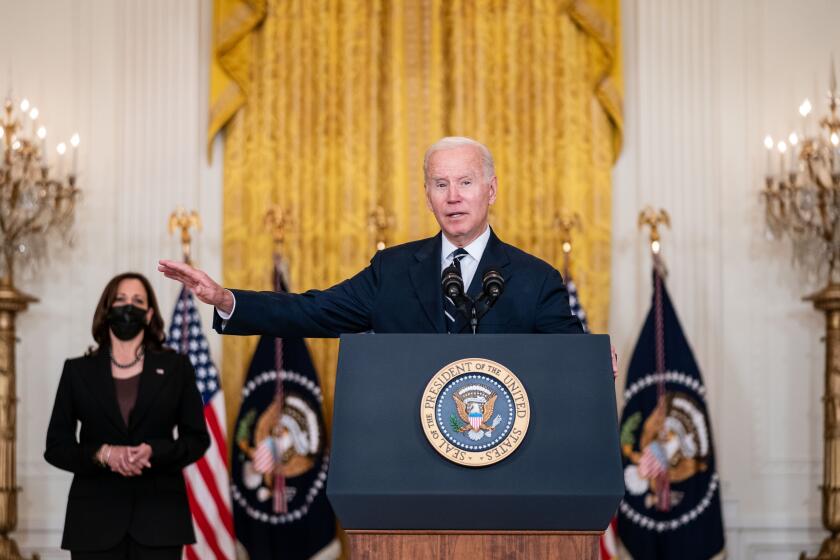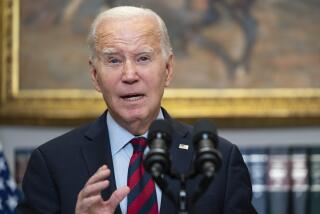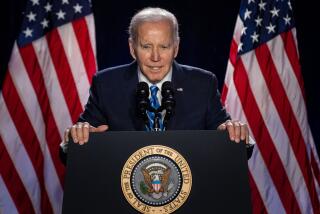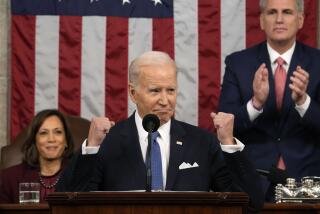‘This is real stuff’: Biden hits the road to sell historic infrastructure law, avoid 2010 replay
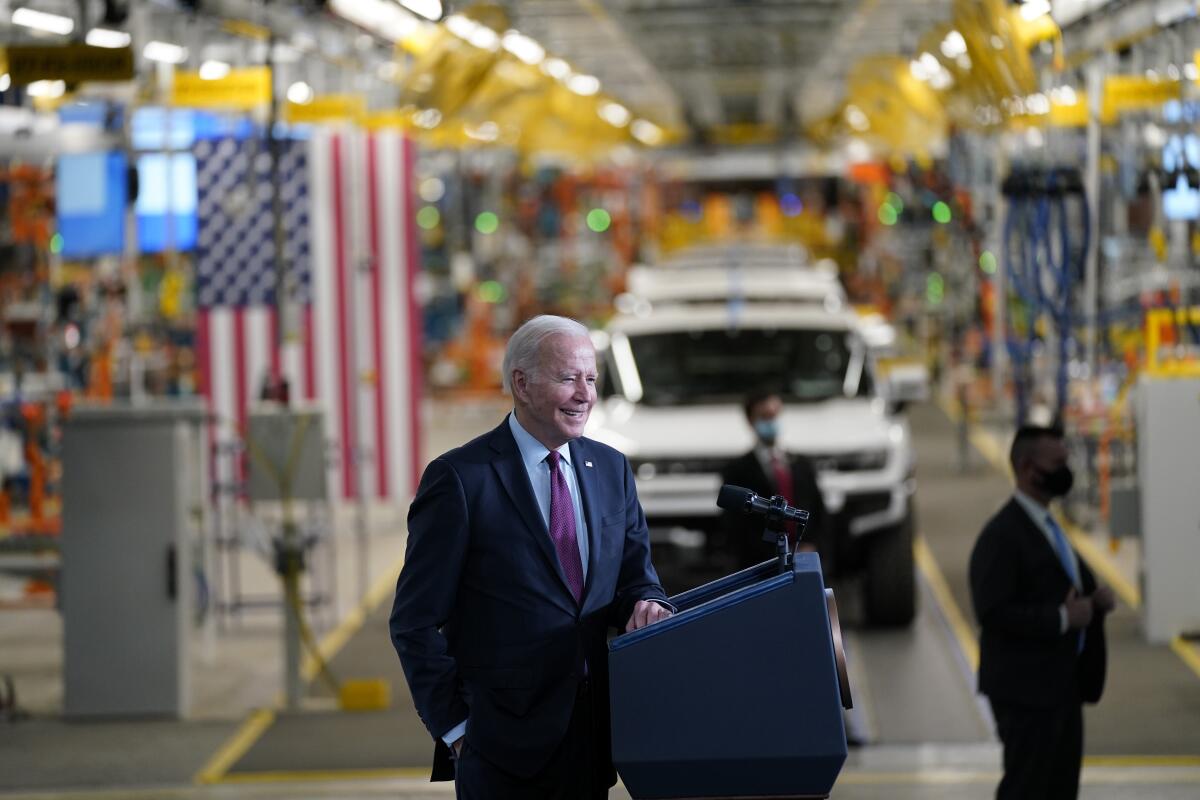
- Share via
When President Obama signed the Affordable Care Act into law in 2010, then-Vice President Joe Biden was at his side. Months later, Biden watched with Obama as Democrats suffered staggering losses at the federal and state level in the midterm election.
Now Biden is the one who needs to sell historic legislation to the American people ahead of what’s expected to be another bleak midterm season for Democrats. This time it’s the $1.2-trillion infrastructure law, the largest such federal investment in decades — and the largest ever in some sectors. And Biden hopes to soon promote the passage of his massive social spending framework, now stalled in Congress, which would fund clean energy, child care, tax credits, affordable housing, expanded healthcare and other initiatives.
The challenge, both then and now, is how to sell voters on plans whose benefits they might not see for several years.
Two days after signing the infrastructure bill into law, Biden took his goodwill tour to General Motors’ electric vehicle assembly plant in Detroit, where he took an electric SUV for a test drive and said: “That Hummer’s one hell of a vehicle.”
Biden said the infrastructure law will invest $7.5 billion in expanding the infrastructure for electric vehicle charging stations. Though lawmakers are still hashing out the final contours of the “Build Back Better” social spending plan, the president maintained the $1.85-trillion proposal would help boost American manufacturing of electric vehicles and offer consumers tax credits to purchase them.
“We’re gonna make sure that the jobs of the future end up here in Michigan, not halfway around the world,” said the president, who was joined Wednesday by members of Michigan’s congressional delegation, GM Chief Executive Mary Barra, United Auto Workers President Ray Curry and Labor Secretary Marty Walsh.
While Biden’s speech on Wednesday highlighted the impact the two major initiatives would have on the auto industry, the environment and creating union jobs, on Tuesday he focused on basic infrastructure critical to rural America: roads, high-speed internet and water systems.
Standing at an 82-year-old bridge over the Pemigewasset River in Woodstock, N.H., Biden made the case that the bill addresses the basic needs of people in small towns across America.
“This is real stuff,” Biden told about 30 residents as snow fell across his face. “What does it mean if a school bus or water treatment trucks or logging trucks can’t cross? It means jobs. It means time. It means energy.” Without access to the bridge, the local Fire Department would need to drive 10 miles out of the way to reach the community, he said.
The bipartisan legislation is a much-needed victory for Biden, who continues to face intraparty fighting over his landmark social safety net bill amid the ongoing pandemic and inflation largely driven by supply chain issues.
Biden’s infrastructure tour comes as the House prepares to vote on the Build Back Better plan. While the impact of that bill would be more immediate, it’s likely to pass entirely on Democratic votes, leaving Biden more open to Republican attacks of overspending.
This is what’s inside President Biden’s “Build Back Better” framework.
He has seen his approval ratings drop even as the Democratic agenda remains popular. In a Washington Post-ABC poll released Nov. 14, 63% of respondents supported spending $1 trillion on infrastructure, but only 39% approved of the way Biden has handled the economy. His overall approval rating is 41%, down from 52% in April.
As the president’s motorcade wound through rural New Hampshire Tuesday, he was greeted by pro-Trump and anti-Biden signs, some reading “Mandates are 4 greed and power,” a reference to rules imposed to fight COVID-19. Just down the road from the bridge where Biden spoke, at least one protestor was heard chanting “Let’s go, Brandon,” a slogan that has become conservative code for a vulgar anti-Biden statement.
“What I think he needs to do is pretty much what they’re already doing, and that’s hit the road and start selling this thing all across the country,” said Jim Manley, who was a senior staff member for former Senate Majority Leader Harry Reid (D-Nev.). Manley played a significant role in helping with the messaging and strategy around the Affordable Care Act.
“One thing we learned from Obamacare is you can’t over-promise,” Manley said. “But you need to figure out how exactly to show people that they’re going to benefit from what was just passed.”
Obamacare’s political journey serves as a reminder of both the importance of messaging and the long game politicians must play as they wait to see how the public receives their legislation. Republican criticisms of the Affordable Care Act — including fears of rising costs and losing beloved doctors and false rumors of “death panels” — dominated the 2010 and 2014 midterm elections.
By the 2018 midterm cycle, however, protecting Obamacare from future repeal attempts was a key component of Democrats’ successful effort to retake the House. As president, Biden has been able to bolster the healthcare law by reducing premium costs through the American Rescue Act.
“The White House and many Democrats for sure will be frustrated at the lag time of how long it takes for people to feel benefits of things,” said Jeremy Rosner, a managing partner at GQR, a Democratic polling firm. “But the Obamacare case shows that, at some point, sound policy on things that touch people’s lives — like healthcare, roads or childcare, things like that — ultimately ... help as messengers and become strong assets.”
That’s little comfort to Democrats heading into next year’s midterm election, a lesson Republicans learned in 2018.
“We were hoping tax reform would be the silver bullet to let us keep the House,” said Matt Gorman, a GOP strategist who was communications director of House Republicans’ campaign arm in the last midterm election cycle. “While I’m glad we did it — it was good policy — it was certainly not that silver bullet.”
House Democrats flipped control of 41 GOP-held seats in 2018. Vulnerable House Republicans had hoped that their legislative wins would distract from the controversies surrounding President Trump, but the tax overhaul alone wasn’t enough to overcome a year that included a government shutdown, the Russia investigation, the separation of families at the U.S.-Mexico border and legal troubles for various aides.
Gorman said Republicans would likely paint Biden as a “bystander,” not a leader, on events such as Afghanistan, the border and inflation.
“You can’t turn a huge trend with a single piece of legislation,” Gorman said.
Historically, the president’s party tends to lose seats in Congress during midterm elections. The 2022 map — currently being redrawn based on the 2020 census — will likely favor House Republicans, according to multiple analyses. And House Democrats in some competitive districts, such as those of John Yarmuth of Kentucky and Ann Kirkpatrick of Arizona, have announced plans to retire.
Unlike the healthcare bill, the infrastructure bill, which won the support of 19 Republicans in the Senate and 13 in the House, will likely retain its popularity. The messaging challenge for the administration is distinguishing what work can be done now and what won’t be shovel-ready for several months or years. Officials have emphasized that this isn’t a 2009 stimulus-style bill designed for immediate effect. While some funds will be directed toward existing programs, many projects will only be in the planning stages a year from now.
Asked about the implementation of the law’s $65-billion broadband service plan, Commerce Secretary Gina Raimondo told reporters earlier this month that communities would see “activity and action” ahead of next year’s midterm elections, but that it would take “some number of months” for projects to get off the ground.
“It’s more important to get it right than to rush,” Raimondo said. “I think people will see their state putting together a plan; they’ll see us starting to move out on that plan. But you know, not everybody’s going to have broadband a year from now.”
This week, several members of the administration, including Vice President Kamala Harris, Environmental Protection Agency Administrator Michael S. Regan and Transportation Secretary Pete Buttigieg are fanning out to red and blue states across the country to promote the bill. The stops include a mix of politically significant regions; urban areas such as San Francisco, Atlanta, and Columbus, Ohio; and cities such as New Orleans, where Regan will highlight the law’s environmental justice funding.
On Tuesday, Biden drilled down on the specific issues the law was intended to address in places like Woodstock, which has a population of about 1,300. He noted that the bridge where he was standing, on New Hampshire Route 175, “has been structurally deficient for years,” with the maximum weight allowed on the bridge dropping from 40 to 20 tons as the state spent a quarter of a million dollars on “Band-Aid” repairs.
The infrastructure law will speed up meaningful repairs on bridges, many on roads in small towns such as Woodstock, by at least one year, he said.
“My message to the people of New Hampshire is simple,” he said. “Because of this delegation, New Hampshire and America are moving again. Your life is going to change for the better. And that’s literal.”
John reported from Los Angeles and Logan from New Hampshire.
More to Read
Get the L.A. Times Politics newsletter
Deeply reported insights into legislation, politics and policy from Sacramento, Washington and beyond. In your inbox three times per week.
You may occasionally receive promotional content from the Los Angeles Times.
